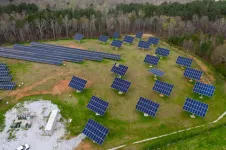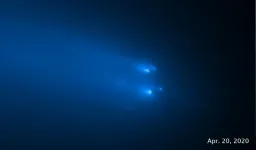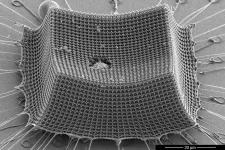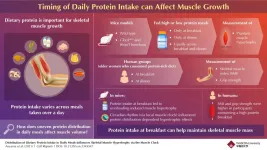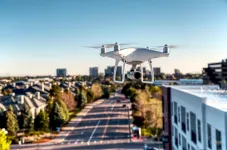(Press-News.org) When it comes to transitioning from carbon-based to renewable source energy systems, Americans are on board. They're less keen, however, having these new energy infrastructures--wind turbines or solar farms--built close to their homes, which creates hurdles for policymakers. That's according to a study from University of Georgia researcher Thomas Lawrence.
Lawrence and an international team conducted surveys in the United States, Germany and Ireland to assess people's attitudes about renewable energy technologies and their willingness to have the necessary infrastructures built nearby.
"People in Germany and Ireland were more open to having renewable energy technologies closer to where they lived, perhaps because they have less space than in the U.S.," said Lawrence, professor of practice in the College of Engineering. "In the U.S., I was happily surprised to see overall support for a transition of power sources--especially to solar and wind--in the electrical grid, and it was stronger than I would have guessed."
Chilly reception for fossil fuels
Respondents in each country were asked to evaluate five energy sources--wind turbines, solar power technology, and more traditional electrical power generation using biomass, coal or natural gas as the power source. They also were asked questions about what distance from their home would be acceptable for the corresponding infrastructure and these energy sources. (The surveys were conducted using the local unit system of the three countries--miles for the U.S. and kilometers for Ireland and Germany. Five kilometers is roughly 3 miles.)
In all three countries, respondents were overwhelmingly opposed to having coal-fired or natural gas power plants located close to their residences. More than 80% chose "greater than 5 km/miles" and "reject regardless of distance" as their preferred distance for coal-fired power plants (89% in Ireland, 91% in the U.S. and 81% in Germany). More than 50% chose "greater than 5 km/miles" and "reject regardless of distance" as their preferred distance for natural gas power plants (80% in Ireland, 77% in the U.S. and 51% in Germany). They were generally more in favor of having renewable energy technologies located closer to their homes.
Respondents in Ireland and the U.S. were less willing to accept biomass power technology in their immediate vicinity, with more than 70% choosing "greater than 5 km/miles" or "reject regardless of distance" options. German respondents were somewhat more accepting, with 55% accepting biomass at distances less than 5 km/miles from their homes. According to Lawrence, the U.S. result may be because people here do not understand "biomass power," which is in essence burning biomass such as wood scraps to power a more traditional electrical generation facility.
A warmer response for renewable energy
Americans were more open to having renewable energy technologies located near their homes, compared to traditional energy technologies, with 24% agreeing to solar infrastructure and 17% agreeing to wind turbines located 0-1 km/miles from their residences. Irish respondents had higher acceptance rates for solar, with 42% agreeing to solar infrastructure 0-1 km/miles from their homes, and slightly lower rates for wind turbines, with 13% agreeing to wind turbines at the same distance. German respondents were far more open to these energy sources, with 74% agreeing to solar and 33% agreeing to wind turbines located 0-1 km/miles from their homes.
Greater acceptance of renewable energy sources in Germany is not a surprise, according to Lawrence.
"Germany has been leading the charge in transitioning away from carbon-based energy sources," he said. "Over 30% of their power right now is through wind or solar. People there are used to seeing wind farms and solar panels on rooftops."
The study, published in The Energy Journal, also examined preferences related to different national energy policy objectives: economic viability, environmental sustainability, reliability of energy supply and social acceptance.
Results revealed that social acceptance is a more significant energy policy concern for Ireland compared to either Germany or the U.S. Respondents in Ireland rank social acceptance as more important than environmental sustainability or reliability of supply. They also place more importance on those three variables compared to economic viability.
In contrast, German respondents rank all the national policy objectives examined as more important than social acceptance, though similarly, they place greater importance on environmental sustainability and reliability of supply than economic viability. Respondents from the U.S. place much lower importance on social acceptance as a national policy objective, compared to the other three policy objectives.
"Respondents in all three countries were generally more in favor of having renewable energy technologies close to their homes--unlike conventional energy technologies like coal and natural gas--but 'close to my home' was different in the U.S. than Europe," Lawrence said. "Five miles was the cutoff, at least in the U.S. Once you get beyond that point, it's out of sight, out of mind. People in Germany and Ireland often don't have the luxury of five miles."
INFORMATION:
Co-authors include Jason Harold, National University of Ireland Galway and Trinity College Dublin; Valentin Bertsch, Trinity College Dublin and Ruhr-University Bochum; and Magie Hall, University of Nebraska Omaha (now with the Vienna University of Economics and Business).
This project was funded in part by the CREDENCE Project (Collaborative Research of Decentralisation, Electrification, Communications and Economics), a U.S.-Ireland Research and Development Partnership Program (centre to centre), funded by the Department for the Economy Northern Ireland (USI 110), Science Foundation Ireland (16/US-C2C/3290) and the National Science Foundation (0812121). Bertsch and Harold acknowledge funding from the ESRI's Energy Policy Research Centre. The U.S. study was funded in part through a grant from Georgia Power/The Southern Company.
A serendipitous flythrough of the tail of a disintegrated comet has offered scientists a unique opportunity to study these remarkable structures, in new research presented today at the National Astronomy Meeting 2021.
Comet ATLAS fragmented just before its closest approach to the Sun last year, leaving its former tail trailing through space in the form of wispy clouds of dust and charged particles. The disintegration was observed by the Hubble Space Telescope in April 2020, but more recently the ESA spacecraft Solar Orbiter has flown close to the tail remnants in the course of its ongoing mission.
This lucky ...
RESEARCH TRIANGLE PARK, N.C. -- Army-funded research identified a new material that may lead to lightweight armor, protective coatings, blast shields and other impact-resistant structures.
Researchers at the U.S. Army's Institute for Soldier Nanotechnologies at the Massachusetts Institute of Technology, Caltech and ETH Zürich found that materials formed from precisely patterned nanoscale trusses are tougher than Kevlar and steel.
In experiments, the ultralight structures, called nanoarchitectured materials, absorbed the impact of microscopic projectiles accelerated to supersonic speeds.
"Increasing protection while simultaneously decreasing the weight that ...
It's no secret that studies show that sexually diverse youth - in particular, lesbian, gay and bisexual (LGB) youth - use more cannabis and experience more mental health challenges than their heterosexual peers.
But what about the changes that occur in the rates of cannabis use: do they precede those related to mental health or is it the other way around? A new study from Université de Montréal offers some answers.
In the Journal of Abnormal Psychology, Kira London-Nadeau, a doctoral student and CIHR Vanier Scholar in the Department of Psychology at UdeM and the CHU Sainte-Justine Research ...
Germany is not meeting its legal obligations to protect refugee women and girls from discrimination. This is the conclusion of a "shadow report" by the University of Göttingen, the association Pro Asyl and the refugee councils of Bavaria, Hesse, Lower Saxony and Saxony-Anhalt. Shadow reports are a useful tool to present important information in parallel with official government reports. Based on current research results and a survey of 65 women's counselling centres, psychosocial counselling centres and institutions working with refugees from all 16 federal states, the study finds that Germany does not adequately protect refugee women and girls and does not meet the requirements of the Istanbul Convention.
"The Istanbul Convention - also known as the Council of Europe convention ...
A coronavirus related to the virus that causes Covid-19 in humans has been found in UK horseshoe bats - according to new collaborative research from the University of East Anglia, ZSL (Zoological Society of London), and Public Health England (PHE).
However, there is no evidence that this novel virus has been transmitted to humans, or that it could in future, unless it mutates.
UEA researchers collected faecal samples from more than 50 lesser horseshoe bats in Somerset, Gloucestershire and Wales and sent them for viral analysis at Public Health England.
Genome sequencing found a novel coronavirus in one of the bat samples, which the team have named 'RhGB01'.
It is the first time that a sarbecovirus ...
UK policymakers preparing trade deals post-Brexit can learn important lessons from New Zealand's 'unique drug agency' the Pharmaceutical Management Agency (PHARMAC), if prices for therapies and access to key drugs are to be protected, say researchers behind a new study.
Over two decades, New Zealand has managed to reduce spending on drugs significantly and consistently despite maintaining access for its population to key treatments. As such, it is an outlier among the world's richest nations: no other OECD country has managed to achieve this.
The investigation from researchers at the universities of Bath and Durham suggest New Zealand's ...
Research led by the University of Southampton into the uptake of the COVID-19 vaccine in Ghana, West Africa has concluded that vaccine hesitancy has seen a small, but significant increase over the last three months. This research is in collaboration with youth-led not-for-profit organisation PACKS Africa.
In the latest survey of 1,295 unvaccinated people, in May/June 2021, willingness to be vaccinated remained relatively high at just over 71.4 percent. However, this figure is down 11 percent on results from March 2021 when an earlier version of the same survey was conducted.
The latest findings show 28.6 percent of respondents are still either undecided or unwilling to get the jab. Among this 28.6 percent group, a little over half said ...
Proteins constitute an essential dietary component that help in the growth and repair of the body. Composed of long chains of amino acids, proteins promote the growth of skeletal muscles, the group of muscles that help us move. Humans have been aware of the benefits of proteins for long. However, recent studies have shown that having the right amount of protein at the right time of the day is essential for proper growth. This is called 'Chrononutrition,' in which when you eat is as important as what and how you eat.
The reason behind this is the body's internal biological clock, called the 'circadian rhythm.' This rhythm is followed by all cells and controls life functions like metabolism and growth. Interestingly, protein digestion and absorption have been ...
Chemical synapses transmit information within the nervous system. When a presynaptic cell is electrically excited, synaptic vesicles fuse with the presynaptic membrane causing messenger substances within the vesicles to be released into the synaptic cleft. These then bind to receptors in the postsynaptic cell where they trigger an electrical signal once again. The temporal and spatial sequence of the incoming signals determines how information is processed and transmitted in the brain. In order to sustain their function in the long term, chemical synapses need to recycle synaptic vesicles to make them available for renewed signal transmission. Professor Carsten Duch and Professor Martin Heine and their respective ...
"The project's main objective is to integrate a certain degree of automation, so that an operator can control a small fleet of up to 10 drones from a single ground station," says Luis E. Moreno, LABYRINTH's coordinator and researcher at the UC3M's Robotics Lab. "The idea is that the operator indicates the mission to be undertaken (for example, monitoring traffic in a particular area) and the system automatically converts this mission into a set of routes that each drone has to follow, automatically calculating alternative routes when necessary," he explains. In addition ...
